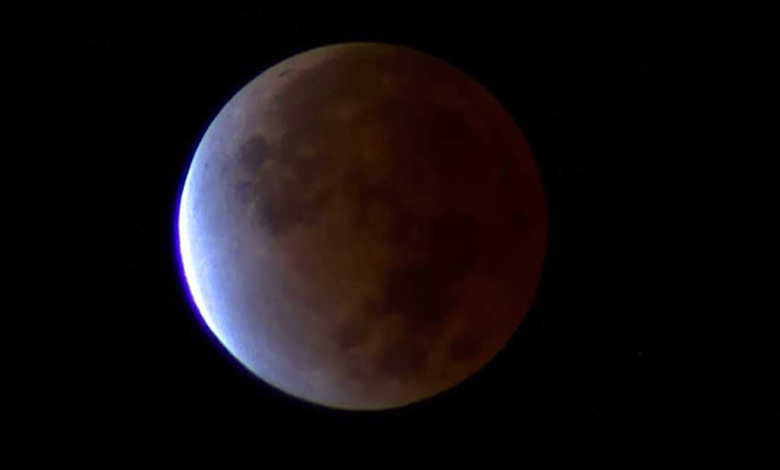

The longest partial lunar eclipse of the century lit up the night sky over Cincinnati. Stargazers looked to the heavens early Friday, treated to a stunning light show. Conditions were near-perfect across the Cincinnati area for viewing. However, the timing was less than optimal, with the peak of the eclipse occurring at 4:03 a.m. Those who slept through the once-in-a-century event can watch a recap in the video player above, as filmed from Crittenden, Kentucky. A lunar eclipse occurs when the sun, Earth and moon align so that the moon passes into Earth’s shadow. In a total lunar eclipse, the entire moon falls within the darkest part of Earth’s shadow, called the umbra.In this eclipse, up to 99.1% of the moon’s disk will be within Earth’s umbra.The moon did not turn blood red like other lunar eclipses, but it was still one of the greatest shows in the heavens with hits of red. Friday’s eclipse was visible across the entire United States.The eclipse began when the shadow of the Earth made its first appearance on the moon Friday morning at 2:18 a.m. Eastern Time.Then the darkness slowly covered more of the moon until 4:03 a.m. when 97.4% of the lunar surface will be dimmed. Although not technically a total lunar eclipse, you could still see some colorful shades of gray and hints of pink along the darkest portions of the moon that is deepest in the Earth’s shadow.The eclipse ended when the Earth’s shadow finally left the lunar surface at 5:47 a.m. returning the moon to its full brilliance.The next lunar eclipse will be May 15, 2022.This history-making, near-total lunar eclipse coincided with the Full Beaver Moon, which reached peak illumination at nearly the same moment as the eclipse’s height. But don’t worry — the moon will appear full from Thursday evening through Saturday morning, meaning you can catch an unencumbered glimpse of the full moon, too.The Beaver Moon gets its name from beaver hunting season, which used to peak this time of year. Plus, beavers start retiring to their lodges for the winter around now, too. Other names for November’s full moon include the Digging Moon (from the Tlingit), the Whitefish Moon (from the Algonquin), and the Frost Moon (from the Cree and Assiniboine).
The longest partial lunar eclipse of the century lit up the night sky over Cincinnati.
Stargazers looked to the heavens early Friday, treated to a stunning light show. Conditions were near-perfect across the Cincinnati area for viewing.
However, the timing was less than optimal, with the peak of the eclipse occurring at 4:03 a.m.
Those who slept through the once-in-a-century event can watch a recap in the video player above, as filmed from Crittenden, Kentucky.
A lunar eclipse occurs when the sun, Earth and moon align so that the moon passes into Earth’s shadow. In a total lunar eclipse, the entire moon falls within the darkest part of Earth’s shadow, called the umbra.
In this eclipse, up to 99.1% of the moon’s disk will be within Earth’s umbra.
The moon did not turn blood red like other lunar eclipses, but it was still one of the greatest shows in the heavens with hits of red. Friday’s eclipse was visible across the entire United States.
The eclipse began when the shadow of the Earth made its first appearance on the moon Friday morning at 2:18 a.m. Eastern Time.
Then the darkness slowly covered more of the moon until 4:03 a.m. when 97.4% of the lunar surface will be dimmed. Although not technically a total lunar eclipse, you could still see some colorful shades of gray and hints of pink along the darkest portions of the moon that is deepest in the Earth’s shadow.
The eclipse ended when the Earth’s shadow finally left the lunar surface at 5:47 a.m. returning the moon to its full brilliance.
The next lunar eclipse will be May 15, 2022.
This history-making, near-total lunar eclipse coincided with the Full Beaver Moon, which reached peak illumination at nearly the same moment as the eclipse’s height. But don’t worry — the moon will appear full from Thursday evening through Saturday morning, meaning you can catch an unencumbered glimpse of the full moon, too.
The Beaver Moon gets its name from beaver hunting season, which used to peak this time of year. Plus, beavers start retiring to their lodges for the winter around now, too. Other names for November’s full moon include the Digging Moon (from the Tlingit), the Whitefish Moon (from the Algonquin), and the Frost Moon (from the Cree and Assiniboine).
Source link








